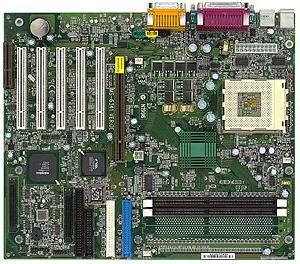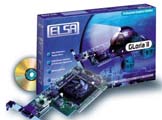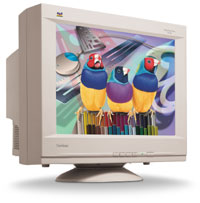Buyer's Guide: High-End Systems - June 2001
by Mike Andrawes on June 11, 2001 12:00 PM EST- Posted in
- Guides
High-end Professional 3D
A high-end professional 3D system requires a number of high-end components. CPU performance is critical and we need more RAM here than any other system we've looked at previously. The graphics requirements are also very different in the professional space and a large monitor is critical.
 Processor
- AMD Athlon 1.33 GHz - $200
Processor
- AMD Athlon 1.33 GHz - $200
At similar clock speeds, the Athlon holds a significant advantage in price
and performance over the Pentium III in professional 3D applications. Since
the Pentium 4 is still too expensive for the slight performance benefit you
get in some professional 3D apps, the decision for our High-End Professional
system's CPU is a no-brainer. For these reasons, we've chosen an Athlon 1.33
GHz, the fastest currently available. Even though it's AMD's top of the line
CPU, it's still quite affordable at $200 thanks to the recent price wars between
AMD and Intel.
The new AXIA core stepping on these processors allows them to overclock fairly easily to 1.4 GHz and sometimes up to 1.5 GHz.
For more information on all Athlon processors, read our AMD Athlon "Thunderbird" 1.33GHz/1.30GHz Review and our Thunderbird / Duron Overclocking Guide.
Motherboard - MSI K7 Master- $175
Motherboards based on AMD's 760 Chipset
are finally available in the "do it yourself" market, allowing us
to finally select it for the buyer's guide. Eventually, production of the standard
760 will slowdown significantly as AMD is not really interested in becoming
a major chipset supplier. For now, however, the 760 is still available and is
the best overall DDR SDRAM chipset available, albeit at a slight price premium
over competing VIA and ALi solutions.

While we haven't reviewed too many AMD 760 based boards, we have had lots of experience with quite a few AMD 760 boards, in particular the ASUS A7M266, Gigabyte GA-7DX, and Microstar K7 Master. The ASUS and Gigabyte are both good boards in their own right, but both lack multiplier controls, which will severely hinder any overclocking attempts. If you're not overclocking, either board will serve you well and offer great performance and stability. The ASUS does offers a more extensive range of FSB speeds and overclocking options than the Gigabyte if you're going to forgo the multiplier overclocking route anyway. The K7 Master, on the other hand, offers similar levels of performance and stability, but adds jumperless multiplier controls.
It's even prepared to handle the needs of a professional 3D workstation since it offers an AGP Pro slot that provides added power for high-end graphics cards. If you want SCSI support, the K7 Master-S is identical with the addition of onboard Adaptec Ultra 160 SCSI.
For more information, see our AMD 760 Chipset Review and April 2001 Socket-A Chipset Comparison.
Memory - 512MB Corsair/Crucial/Mushkin CAS2.5 PC2100 DDR SDRAM - $75
Since memory is so cheap and the type of applications that will be run on
this machine are memory hungry, we'll go ahead and max out our K7 Master's two
DIMM slots. The largest DDR SDRAM modules that are readily available today are
256MB each, so that means 512MB of PC2100 DDR SDRAM to keep this system running
smoothly at all times.
As for the exact brand of memory, we recommend Corsair, Crucial, or Mushkin modules. We use them in our test systems and have had absolutely no problems with them.
 Video
Card - ELSA GLoria III (NVIDIA Quadro2 Pro) - $600
Video
Card - ELSA GLoria III (NVIDIA Quadro2 Pro) - $600
Although NVIDIA has announced the Quadro DCC, it's still impossible to find an individual card for purchase. You can buy it in a complete OEM system at this point, mirroring the situation at the launch of both the Quadro and Quadro2 Pro. The Quadro DCC offers essentially the same programmable GPU found in the GeForce3, but is clocked higher and enables certain features that were left disabled on the GeForce3. Among these features is enhanced support for anti-aliased points and lines, which, although it isn't a commonly used feature with most users, was an extremely poor performance point for the GeForce.
For now, the Quadro2 Pro is the best you can do if you're building a 3D workstation on your own. With their previous experience in the professional market, ELSA was able to score exclusive rights to manufacture the Quadro series. The Gloria III is their Quadro2 Pro product, offering 64MB DDR SDRAM. At $600, the Gloria III is a relative steal compared to some of the other professional 3D accelerators out there. The fact that it's fully support under Windows NT 4.0, Windows 2000, and Linux doesn't hurt either.
Depending on the work you do, a 3D accelerator from a manufacturer with a longer history in the professional 3D arena may make more sense. Maybe a FireGL or Oxygen series card.
For more information, see our ELSA Gloria II Review.
 Monitor
- Viewsonic P220F - $775
Monitor
- Viewsonic P220F - $775
With the price of 21-22" monitors dropping so much recently, it's finally
time to bump up to a good 21-22" monitor. The toughest part of this decision
may be between an aperture grill or traditional CRT. Aperture grills are used
in Sony Trinitron and Mitsubishi DiamondTron tubes, with the latest versions
of these being perfectly flat. The disadvantage of aperture grills are the fine
lines produced by the damper wires required to hold the grill in place. Some
people find the flatness and brightness of the design to be worth the sight
of the damper wires, while others can't stand them. As such, this is a very
personal choice.
Nevertheless, we're going to make a recommendation here anyway. The Viewsonic P220F is a reasonably priced 22" monitor using a DiamondTron NF tube. It supports resolutions up to 1600x1200 and has a 0.25 - 0.27 variable grill pitch.










0 Comments
View All Comments